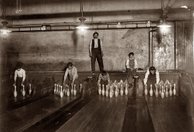Capital Area Bowling Review Our 17th Year!
Also Visit
History of Bowling
History of Bowling
Before This
Bowling had This
Interesting Bowling Facts
Wood or Synthetic
Lanes can be made of wood or a
synthetic surface.
---------------------------------------------
The first Mineralite ball was
introduced in 1914 by the
Brunswich Corporation
---------------------------------------------
The first commercial installation of a pin setting machine came in 1952
---------------------------------------------
Variations of Bowling
Many other games have come from the game of bowling. Including:
Italian bocce ball
French pentanque
Britain’s lawn bowling
Click below for larger View
Did you know
* Bowling has a long and very colorful history
* Bowling is the oldest sport on the face of the planet!
* At one time it was against the law to bowl
* Bowling used to be part of a religious ceremony
* Bowling lanes were installed on almost every military
base and was the "official recreation" of the military
Each year more than 70 million people in the United States bowl. There are more than 3.2 million sanctioned bowlers that compete regularly in league play (Including Junior Bowlers).Bowling has evolved and has risen steadily over the years, decades and even centuries. Entering a bowling center today with it’s automatic pin setters and scorers is a far cry from what bowling use to be, even a mere 30 years ago and light years ahead of the way it was at the beginning.
Even the most avid bowler would never realize just how far back bowling goes. When do you think bowling first began? 1940? 1910? 1870? 1521? No keep going. 1210? You’re still way off. You need to go back over 5,000 years to 3200 BC. The game of bowling has been traced to articles found in the tomb of an Egyptian child buried in 3200 B.C. The primitive game included nine pieces of “stone pins” at which a stone "ball" was rolled. In fact one of our modern day rules for the game of bowling was originally set in 3200BC. This rule came from another variation of the game of bowling, which has had many variations over the years, and in fact still does (Duck Pins and Candle Pins). The ancient Polynesian game of ula maika, also utilized pins and a ball of stone. The stone Ball was rolled at targets 60 feet away, the same distance that is the standard regulation distance from the foul line to the pin deck in today’s game of bowling called ”tenpins”.
The more recent version of bowling as we know it today is thought to have originated in ancient Germany, not as a sport but as a religious ceremony. Martin Luther is credited with settling on nine as the ideal number of pins. Apparently he also left a lot of ten pins! The game caught on throughout Europe, and then into the Scandinavian countries, and finally it migrated to the United States. The earliest known reference to the American game of bowling was made by author Washington Irving in 1818 in "Rip Van Winkle." By this time Bowling was being played throughout the world but the rules were different almost everywhere. Even basic equipment was not the same. In fact, (those of us who leave the 10 pin with regularity might not want to listen to this but…) it was the American’s who added that extra tenth pin and named it bowling. (What were they thinking?)
Bowling caught on and became popular in the mid 19th century. For the first time, indoor lanes started being built. Some of the first “Bowling Centers” were built in Manhattan, Bronx, Syracuse, Buffalo, Cincinnati, Chicago and Milwaukee. Most of these cities had large German populations which made sense because the game of bowling was very popular in Germany.
In 1875, delegates from nine bowling clubs in New York and Brooklyn met in Germania Hall in the Bowery and organized the National Bowling Association. This was the first attempt to organize the game of bowling. However, as with most projects, with many people trying to “organize and formulate” there were many, shall we say, ideas on how it should be done. Disagreement was the only thing anyone could agree on. The delegates from the East and West couldn’t agree on anything. New York State bowlers were united in their alignment against everyone else to the west. Finally, On Sept. 9, 1895, the American Bowling Congress was organized in Beethoven Hall in New York City. The ABC would become the governing body for all bowlers for 110 years. In 2005 the ABC became the USBC (United States Bowling Congress).
For the women out there, (who are now also under the USBC) the WIBC, Women’s International Bowling Congress, was started by a group of 40 women who were encouraged by Dennis Sweeney, a bowling proprietor (The owner of a bowling center is called the Proprietor) in St. Louis. These women met in Sweeney’s bowling center in 1916 and formed the WIBC.
For the past 187 years the game hasn’t changed much. The equipment and technology has made giant leaps and continues to do so and hopefully will continue into the future. So the next time you “shoe up” (put on your bowling shoes) and play the game, think about all the history. You’re playing a game that has been around since 3,200 years before Jesus walked this Earth. That means bowling has been around for 5,216 years and counting! Bowling may be the oldest Sport on the face of the earth that is still played today.










